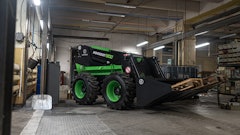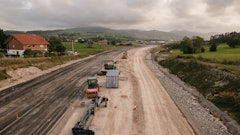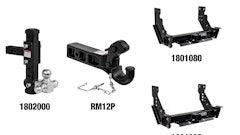
For most of us, 2021 couldn’t come soon enough. Now that we’re into the New Year, we’re all still thinking about one big question: what are we in store for this year?
Now, I can’t answer that question for everything, but I can offer some thoughts on what is going to affect equipment availability and pricing, and the industry as a whole.
Revisiting my construction and used equipment industry outlook from last year, I had to laugh a bit. Amidst some pretty good predictions, there was no mention of COVID-19, the biggest factor that would dominate 2020. And just as political and economic factors had a big influence on the industry last year, they will again in the year ahead.
Adaptability and Resiliency
While it’s hard to look back at 2020 and find many positive notes, I’m going to. I was incredibly proud of our industry, one that has proven time and time again to be among the most adaptable and resilient, and we saw everyone step up that game in 2020.
Contractors adopted new safety protocols on jobsites. Equipment dealerships implemented in-store social distancing measures and no-contact parts and service support. We all collaborated so we could keep working. This overall adaptability is something we’ll have to continue this year, focusing again on an enhanced safety mindset and practices.
Also read: How Contractors and Dealers Continue to Work Together Safely & Efficiently During the COVID Crisis
Aside from what COVID-19 brings this year, I’d like to take a look at four factors affecting equipment availability and pricing, plus one key takeaway that will impact the equipment industry across virtually every sector.
1. Housing Starts
Always one of the leading indicators of a healthy construction industry, housing starts were one of the brightest spots of 2020, even amidst fluctuation throughout the year. While there were some low points late in the spring, residential construction saw gains in the summer, and the AGC’s December 2020 report showed residential construction had expanded again later in the year. Low interest rates greatly contributed to strong housing starts, as did people’s optimism and faith that COVID-19 recovery would be strong.
As a result, it was also a good year for compact construction equipment. Sales of smaller machines like skid steers, compact track loaders and compact excavators were strong. These jobsite staples are especially popular in new home builds. So, provided housing remains strong or even stable, I expect compact construction equipment demand to be high again this year.
Housing starts will be an important area to watch and early indicators are that we might be in for another strong year. Many experts are predicting another solid housing market thanks to increased demand from buyers who delayed purchasing because of the pandemic. They are also citing demand from existing homeowners who need larger spaces to accommodate parents working from home and children attending school virtually.
As important as strong housing starts are to boosting the health of our industry, if we start to see a slowdown, it will negatively affect us – and quickly.
2. Mining
After a rough go of it in the past few years, mining started to see an impressive recovery in late 2020. Now, I’m not talking about the legitimacy of mining Bitcoin or rewards of cryptocurrency – although, depending on your point of view, that’s a potentially profitable mining conversation. I’m talking traditional mining using that Hitachi excavator to dig into the earth for precious metals. While they’re often looked at as a separate sector, I’m also referring to aggregates and quarries here, too.
One of the key reasons all areas of mining have been doing well and are looking to be strong in 2021 is largely driven by their close relation to housing starts. Sand and gravel are needed for roads and exterior work, while certain metals, like copper, are used in homes.
Another reason for the strength of mining is that fleet owners within the sector are among the most sophisticated. These owners know the costs of everything related to their fleet management and are early adopters of technology. We see it all the time: companies that invest in technology and caring for equipment are better poised to come out of tougher times stronger.
The projected health of the mining industry is another factor I predict will drive heavy equipment demand higher in 2021 – think those large excavators, along with dozers and dump trucks. In addition, machine intelligence and machine control systems, unmanned aerial vehicles (UAVs, otherwise known as drones) and even autonomous vehicles are more common on mining sites compared to most other heavy equipment sites, and we’ll continue to see growth in technology demand.
At RDO Equipment Co., we have a division and people dedicated to the support of mining technology, particularly solutions from Carlson, and other equipment and software brands. Dealers that haven’t made the investment to strengthen technology offerings and support will need to make it a priority.
3. Oil Production
While not as rosy an outlook as housing starts or mining, oil is still another area I believe is an important one to watch. Oil prices remain lower than we’d like and I don’t expect them to climb back up to that $70 per barrel sweet spot. But we are seeing some silver linings. Oil producers, primarily those in West Texas, are finding ways to be more efficient and cost-effective, which is encouraging production.
I’m not predicting an oil boom or anything close to one, but I do believe it’s going to be better than expected. I anticipate slow, steady growth in the industry for the year ahead. Along with that, there will be demand for heavy equipment that creates and maintains sites, as well as machines to transport materials and the finished product.
4. New Administration
I’m not here to get political but I’d be remiss if I didn’t acknowledge that the new administration is going to have an impact on our industry.
As I write this, I have no idea what the long-term effects will be. But history has shown us that election years are typically weaker ones in the equipment industry. No matter which side of the aisle you’re on, or if you’re not aligned with either party, the simple fact is a change in administration causes concern for many. When the future has any degree of uncertainty, contractors tend to be a bit more conservative with equipment purchases and other business investments.
While confidence may falter, we may see an infrastructure bill to help stimulate the economy. A bipartisan infrastructure bill has been in talks for years, yet nothing has made it to the finish line. Maybe now this can get the focus it deserves.
Also read: 2020 Votes for Transportation Give Construction Hope for 2021
I have been a strong proponent of an infrastructure bill for a few years now and I have to believe everyone in our industry is rooting for one. The need is not going away; in fact, it gets stronger every day. Things like roads, water and sewer are all used daily and incur daily wear and tear. In addition to filling these essential needs, a bill would strengthen the backlog, create jobs and increase demand for machines, both new and used, and rental agreements.
A proper infrastructure bill will not be cheap. Interest rates are at an all-time low and economists are saying inflation is inevitable. But it may be that the stars have aligned for an infrastructure bill and we’ll all want to watch closely to prepare.
Continued Rental Popularity
The factors I’ve discussed lead me to an overall 2021 prediction: it will be another strong rental year. Because we’ve been through a down cycle and are going into a more stable one, I believe a lot of people have held onto equipment rather than selling or sending to auction. I recently spoke with friends from Ritchie Bros. who confirmed the slowdown at auctions. With fewer machines, auction prices are running higher and it’s something we’ll be tracking throughout the year.
There’s also supply chain issues, or COVID-19 lag, that’s affecting manufacturing and machine availability. We’re seeing a shortage of new equipment which may bring price inflation.
Don’t get me wrong – there are signs of positivity and optimism that point to it being a great time for contractors to invest in and grow their fleets with new and used equipment purchases. The simple fact is it may be more challenging to do so this year, making rental a good option.
Navigating Another Year
Because of how COVID-19 has taken our world by storm, it’s a bit more difficult to look into the crystal ball and try to make any predictions about the near or distant future. But if my 25 years in this industry have taught me anything, it’s that the construction industry is adaptable and resilient. We’ve made it through down years and challenges, and we’ll continue to do so. In general, I think the opportunity we all have, regardless of industry, is not to get stuck in the negative and just go do what we do. And that’s a prediction I’d be willing to stand behind any year.






























